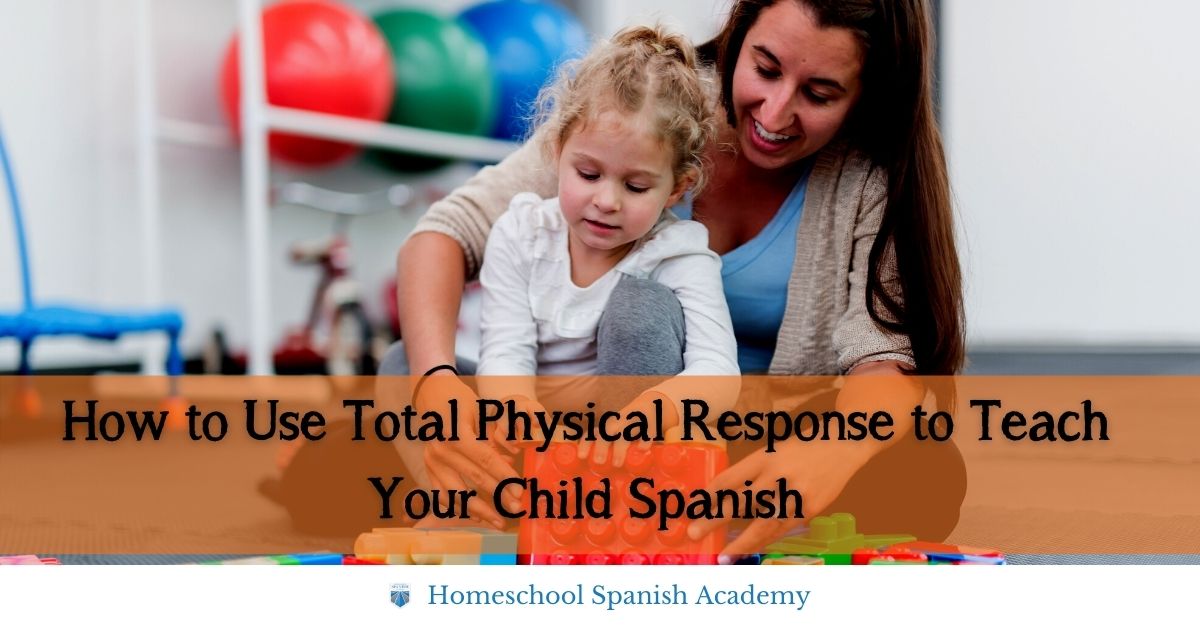
How to Use Total Physical Response to Teach Your Child Spanish
Total Physical Response (TPR) is a great tool for teaching basic Spanish vocabulary to beginning learners.
What is TPR, exactly?
It’s a movement-based technique for teaching new vocabulary or phrases. In fact, the TPR process mimics the way infants learn their native language. To boost language and vocabulary learning, Total Physical Response aims to create a brain link between speech and action.
Keep reading to learn more about TPR and how you can use it to teach your child Spanish!
What is TPR?
Total Physical Response was developed by James Asher, a psychology professor at San Jose State University in California in the 1960s, who observed that traditional second language programs had a dropout rate of almost 95%.
He believed this was due to the flawed and ineffective methods being used in the programs. In an attempt to improve the dropout rate, Dr. Asher himself developed TPR and suggested that it be used in association with other methods and techniques.
TPR combines various theories and methods such as learning theory, developmental psychology, and humanistic pedagogy.
In more practical terms, teaching with TPR involves saying a word or a phrase and demonstrating an action along with it. After the teacher repeats it a few times, the students can repeat the word and do the action.
Total Physical Response is especially useful to teach and practice:
- Action verbs (sonreír, correr, cantar, reír)
- Verb tenses (past, present, and future)
- Commands and instructions (ponerse de pie, cierra los ojos)
- Storytelling

How is Total Physical Response Beneficial for Learning a New Language?
Although TPR is not intended to extend beyond the beginner level, it can be modified for preschoolers or elementary school children, or even middle schoolers.
Total Physical Response is fun; students enjoy it, and it lifts the pace and the mood of the class or tutoring session.
TPR also helps students to remember phrases or words. It’s perfect for active kinesthetic learners who need a break from desk work.
Through Total Physical Movement, bodily actions convey each new word’s meaning effectively. In this way, students are able to quickly understand and use the target language.
TPR involves both left- and right-brained learning. The left side of your brain is normally the language learning center. Combining both hemispheres stimulates connections, imagery, and logic.
Total Physical Response posits that memory is enhanced through association with physical movement. Finally, it reduces student inhibitions and lowers their stress level.
How does Total Physical Response Mimic Native Language Acquisition?
Total Physical Response is modeled upon the way children learn their native language.
Parents use body language in speaking to their children from infancy. For example, a parent might say:
- “Pick up the ball.”
- “Sit down.”
- “Eat your lunch.”
- “Look at me.”
For months before the child starts to speak, they are absorbing all the language, sounds, and patterns they hear. Eventually, the child reproduces the language spontaneously. The child looks to their parents for instructions and performs the movements required. The child doesn’t need to be able to say the words, just to listen and understand.
TPR attempts to mirror this in the language-learning process.
According to TPR theory, comprehension—not word production—is the first step in language acquisition.
A simple listen-and-repeat technique is the main technique TPR. It has been proven effective for teaching foreign languages to beginners. For example, you could teach ¡Levantense! (“everyone stand up”) in Spanish by repeatedly standing up while saying the command.
Since listening is the foundation for acquiring many other language skills, the meaning of the words should be emphasized. The child does not necessarily need to communicate at first, they just need to focus on repeating or responding.
Total Physical Response Strategies and Tips
Total Physical Response is mainly based on commands and actions, but the methodology also involves other areas of language learning and usage.
The process itself is simple and effective, encompassing three essential principles:
- Students listen before speaking.
- Students learn through commands.
- Students’ target language speech evolves from listening.
Here are some strategies and tactics for implementing TPR to teach your child Spanish!
1. Create a Stress-free Learning Environment
Develop a relaxed learning process by keeping the information simple at first. Model for your students before commands are given.
Start with simple commands to keep stress levels low. Give constructive feedback, enabling students to improve as they listen, repeat, and respond.
2. Use Props
For intermediate to advanced TPR classes, it’s fun to use objects in the lessons. An example of utilizing TPR materials is having a student walk to the front of the classroom, grab a specific item, then carry it to another student to give it to them.
3. Prepare
Select the vocabulary that you are going to teach. Collect the items, props, or pictures you’ll use to illustrate the meaning of the words.
See also: 100 Easy Spanish Words for True Beginners
4. Model and Repeat
Say the new vocabulary word for the students. As you do so, use exaggerated gestures, facial expressions, props or body movement to illustrate the meaning of the word.
Have students mimic the same gestures, facial expressions, use of props, or body movement as you say the word.
Then, ask them to say the word as they are making the movement. Finally, do the action without saying the word and have students say the word.
Be sure to write the word or phrase so that students can make the connection between oral and written words.
Review and practice words with students multiple times to ensure learning. Review words regularly to make sure that students do not forget old words.
Total Physical Response Learning Activities
TPR is enjoyable for kids because it gets them up, moving, and shaking. Here are 6 simple activities and games you can use to implement TPR in a lesson.
1. Simple Commands
Initially, you will simply state a command or phrase and the child will perform or repeat it. It’s ideal to introduce just 3 to 5 new words per day to avoid overwhelm.
Hand-picked for you: How to Form Affirmative and Negative Commands in Spanish
2. Combined Commands
As soon as your child consistently understands isolated words, start giving slightly more complex commands.
Instead of simply saying corre (“run”), say corre al arbol (“run to the tree.”) You can add in adverbs over time as well.
Corre rápido al árbol y toca lentamente una hoja.
Run quickly to the tree and slowly touch a leaf.
3. Series of Commands
Eventually, with consistent use of TPR, your child will start to understand multiple directions in a row. For example:
Recoge el peluche. Llévalo a la mesa y déjalo allí. Entonces camina a la puerta y ábrela.
Pick up the stuffed animal. Take it to the table and leave it there. Then walk to the door and open it.
4. Movement with Songs
Attaching motions to the lyrics when you sing songs is a form of TPR. Rather than passively listening, the students connect to the words by acting them out.
Try out some of our recommendations:
- 10 Songs in Spanish for Kids
- 15 Popular Songs for Kindergarten
- 10 Spanish Alphabet Songs for Kids
- Learn Spanish with Music for Preschool and Elementary
5. Simon Dice
This classic game incorporates TPR. The teacher rapidly calls out terms for the student to act out. As long as she says “Simon Says” (or in Spanish, “Simon dice”) first, the child should pantomime the action. If she doesn’t say “Simon Says,” the child should stay still and not act out the command.
Simon dice levanta las manos.
Simon says raise your hands.
Simon dice toca tus rodillas.
Simon says touch your knees.
Simon dice canta como un pájaro.
Simon says sing like a bird.
6. Charades/Pictionary
Divide into two small groups, and have a representative from each group act out or draw phrases you’ve written on scraps of paper. It’s nice to give the option to do either, as some kids prefer drawing to acting and vice versa.
Give each group two minutes for guessing, and let the artist or actor keep the paper if their team guesses correctly. Play several rounds and see who wins!
Put Theory Into Practice
While you should employ TPR alongside other methods and techniques, Total Physical Response is a unique way to change the dynamics and pace of a Spanish lesson.
Do you lack the time or know-how to teach your child Spanish? We can help! Sign your child up for a free class at Homeschool Spanish Academy. Our professional, certified, native-speaking teachers use Total Physical Response and other methods to get your child speaking Spanish from the first class!

Want more free Spanish lessons, fun content, and easy learning strategies for kids? Check these out!
- How to Finally Roll Your R’s – And Why It’s Not a Big Deal If You Can’t
- The 25 Most Useful Spanish Phrases You Need to Lear Today
- From ‘Hola’ to Holding Conversations: Your 30-Day Beginner Spanish Challenge
- How to Learn Spanish as an Adult (Even If You Think It’s Too Late)
- Spanish Fluency for Beginners: Why 1-on-1 Lessons Work Best for Elementary Kids
- 5 Proven Ways to Boost Spanish Proficiency in Elementary Beginners — Even If You Don’t Speak Spanish
- 5 Mistakes That Prevent Kids from Improving Spanish — and How Parents Can Help Fix Them
- How to Help Your Child Speak Spanish with Confidence (Without Feeling Embarrassed!)
- Ver Conjugation: Free Spanish Lesson, Exercises, and PDF - December 5, 2024
- What Are the Different Levels of Language Proficiency? - October 17, 2024
- Master All the Forms of Ser in Spanish: Your Ultimate Grammar Guide - July 18, 2024




